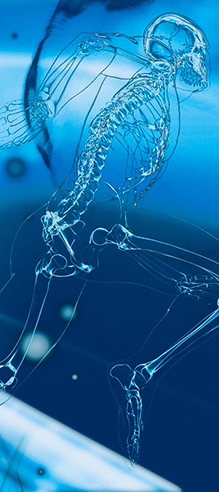Sports Medicine

No athlete likes to be sidelined with an injury. The goals of NTXMSK is to get an athlete safely back into action as soon as possible. Return to play refers to the point in recovery from an injury when an athlete is able to go back to playing sports at a pre-injury level. With the right game plan, from early diagnosis and treatment to full functional rehabilitation, procedures at NTXMSK safely accelerate your return to play.
Osteopathic Manipulation
When the body is worked hard, the muscles and connective tissue can develop small impingements, micro-tears, and strains. Skeletal structural misalignments occur. These subtle conditions affect performance by restricting range of motion and inhibiting healthy muscle function. And, they often are not detectable by imaging procedures.
A physician trained in Osteopathic Manipulative Medicine is able to palpitate the tissue, locating conditions that prevent optimal physical function. Release of these physical restrictions allows the body to move more freely and the muscles to function properly. Optimal function of the body allows an athlete to achieve their highest level of performance. Learn more
Regenerative Orthopedics
Musculoskeletal tissue does not always heal the way we would like. Small tears in tissue, such as muscles, tendons and ligaments, can go unnoticed. Small tears become big tears. Healing is slow and often incomplete. Recovery time keeps you out of the action.
The primary objective for NTXMSK when treating musculoskeletal injuries is to get you back into action fast and safely. Bone Marrow Aspirate Concentrate (BMAC), commonly known as Stem Cell Therapy and Platelet Rich Plasma (PRP) does just this by supplying autologous cells that accelerate and enhance the healing process without the down time of surgery.
Benefits of Regenerative Medicine
Natural Healing:
Regenerative Medicine treatments harness the body's innate healing
mechanisms, promoting long-term recovery rather than temporary
symptom relief.
Enhanced Tissue Repair:
Regenerative Medicine aims to repair and regenerate damaged tissues,
potentially restoring function and reducing the need for more invasive
treatments.
Reduced Risk of Side Effects:
Unlike corticosteroids, regenerative therapies generally have fewer
and less severe side effects, as they use natural substances from the
patient's own body.
The Promise of Regenerative Medicine
Regenerative medicine offers a transformative approach to treating musculoskeletal conditions by harnessing the body's natural healing capabilities.
- Platelet-Rich Plasma (PRP) Therapy: PRP therapy involves extracting a small amount of the patient's blood, processing it to concentrate the platelets, and injecting this platelet-rich plasma into the injured area. PRP is rich in growth factors that promote tissue repair and regeneration.
- Bone Marrow Aspirate Concentrate (BMAC), commonly known as Stem Cell Therapy: Stem cell therapy uses the patient's own stem cells, typically harvested from bone marrow or adipose tissue, to promote healing. These stem cells can differentiate into various types of cells needed for repair, such as cartilage or tendon cells.
- Prolotherapy: Prolotherapy involves injecting a solution, often containing dextrose, into the damaged area. This solution irritates the tissue, triggering the body's natural healing response and promoting the repair of ligaments and tendons.
Regenerative procedures are designed to help reduce knee pain and improve function with precise
highly specific image-guided medical procedures.
Optimal muscle function and performance
Skeletal muscles are made up of hundreds or even thousands of muscle fibers that are bundled together and wrapped in connective tissue. Muscles contract when these string-like structures slide over each other. Sometimes overuse, trauma, or poor warm up causes the muscle tissue and the fascia surrounding them to become irritated and constricted, resulting in restricted movement and less than optimal performance. Muscles are unable to function in a full range of motion or at full strength. Other structural areas step in to compensate. The musculoskeletal system no longer functions as it is designed. Removal of structural blockages with OMT and quick repair of compromised tissue keeps your body functioning at its peak, both now and in the future. Learn more
Common sports injuries
Shoulder. Rotator cuff injuries, Ligament damage, Labral tears, Dislocated shoulder
Elbow. Tendinopathy of the elbow, Overuse injuries, Biceps tendinitis, "Tennis Elbow", or lateral epicondylitis, "Golfer's Elbow", or medial epicondylitis
Knee. Meniscus & cartilage tears, Ligament injury, Iliotibial band syndrome
Hip. Groin pulls and strains, Iliotibial band syndrome, Osteoarthritis, Gluteal Tendonopathy, Hamstring Strains
Foot & Ankle. Ankle sprain/strain, Achilles tendonitis/-osis, Achilles tendon rupture
Back. Muscle or ligament strain, Bulging or ruptured disks
Understanding the Risks of High-Dose Corticosteroid Injections
The management of pain and inflammation is a critical aspect of patient care in musculoskeletal medicine. High-dose corticosteroid injections have been a mainstay treatment for various conditions such as arthritis, tendonitis, and bursitis. However, while these injections can provide rapid relief, they are not without significant risks. Learn more about the negative effects of cortisone in Dr. Minotti's blog.
The Downside of High-Dose Corticosteroid Injections
Corticosteroid injections work by reducing inflammation, thereby alleviating pain. However, the use of high-dose corticosteroids comes with several potential adverse effects:
- Joint and Tissue Damage: Repeated corticosteroid injections can lead to the weakening of tendons, cartilage, and bone. This can result in joint instability and an increased risk of tendon ruptures.
- Osteoporosis: High doses of corticosteroids can accelerate bone loss, increasing the risk of fractures and osteoporosis.
- Infection Risk: Corticosteroid Injections can suppress the immune system, potentially leading to infections such as septic arthritis.
- Endocrine Disruption: Corticosteroids can interfere with the normal function of the adrenal glands, potentially causing hormonal imbalances and conditions such as Cushing's syndrome.
- Short-Term Relief: While corticosteroids can provide rapid pain relief, this effect is often temporary, necessitating repeated injections and increasing the risk of cumulative damage.
We Can Help
To learn more about what we can do to help with your elbow condition, call our office at 817-416-0970. We will thoroughly diagnose your condition and present you with treatment options. From there we will guide you along your road to recovery.